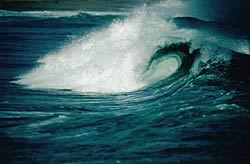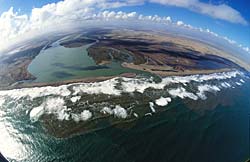| |
|
 |
|
Benguela Current Large Marine Ecosystem |
The LME Framework
In the immediate years following the United Nations Conference on Environment and Development (UNCED), increasing international concern was expressed over the deteriorating condition of the world’s coastal ecosystems that produce most of the world’s living marine resources.
 Within the nearshore areas and extending seaward around the margins of land masses, it was noted that coastal ecosystems are being subjected to increasing stress from toxic effluents, over fishing, habitat degradation, excessive nutrient loading, harmful algal blooms, emergent diseases, fallout from aerosol contaminants and episodic losses of living marine resources from pollution effects and over-exploitation. Within the nearshore areas and extending seaward around the margins of land masses, it was noted that coastal ecosystems are being subjected to increasing stress from toxic effluents, over fishing, habitat degradation, excessive nutrient loading, harmful algal blooms, emergent diseases, fallout from aerosol contaminants and episodic losses of living marine resources from pollution effects and over-exploitation.
To achieve the UNCED objectives, an ecological framework of management, the Large Marine Ecosystem (LME) concept was proposed and adopted. An essential component of such a management regime is the inclusion of a scientifically based strategy to monitor and assess the changing states and health of the ecosystems by tracking key biological and environmental parameters.
This management system includes regulatory, institutional and decision-making aspects, as well as the scientific information on conditions, contaminants and resources at risk within the geographic extent of the ecosystem.
LMEs are described as relatively large bodies of water (200,000 sq. km) with distinctive bathymetry, hydrography, productivity and trophically dependent populations. Sixty four LMEs have been classified around the margins of the Atlantic, Pacific and Indian Oceans which produce 95 percent of the annual global fisheries biomass yields. An assessment of the state of LMEs is usually based on the following criteria: ecosystem productivity, fish and fisheries, pollution, socio-economic conditions and governance protocols.
The Benguela Current LME
 Angola, Namibia and South Africa share one of the most productive ecosystems on earth. The Benguela Current Large Marine Ecosystem (BCLME) extends from Angola’s Cabinda Province in the North, to just east of Port Elizabeth in South Africa. The BCLME is richly endowed with both living and non-living resources, and its location at the southwestern corner of the African continent means it is a critical crossroads for environmental variability, ocean circulation and international shipping. Angola, Namibia and South Africa share one of the most productive ecosystems on earth. The Benguela Current Large Marine Ecosystem (BCLME) extends from Angola’s Cabinda Province in the North, to just east of Port Elizabeth in South Africa. The BCLME is richly endowed with both living and non-living resources, and its location at the southwestern corner of the African continent means it is a critical crossroads for environmental variability, ocean circulation and international shipping.
Rich fisheries, particularly hake, sardines, horse mackerel, anchovy, tuna, rock lobster, deep sea crabs and squid occur throughout the Benguela region, adjacent to one of the most arid yet fascinating desert regions on the planet. On the shelf, underneath these productive waters, rich deposits of oil, gas and diamonds occur. Modern technology is unlocking these resources at an unprecedented rate and new resources are being discovered in ever-greater depths. This flush of development carries with it the responsibility of nurturing and caring for these resources on behalf of the current and future inhabitants of southern Africa.
Fisheries: The productive waters of the Benguela Current support a number of commercially exploited fish, including hake, anchovy, sardine, horse mackerel and tuna, as well as crustacean fisheries for rock lobster in the south and shrimp and deep-sea crab in the north.
 In Namibia, the fisheries sector is the second largest export earner in the economy, after mining. Earnings from fishing grew from $48 million (4% of GDP) in 1991 to $336 million (6.6% of GDP) in 2002. More than 20 commercially important species are targeted and total landings amounted to 623 391 tons in 2002. In Namibia, the fisheries sector is the second largest export earner in the economy, after mining. Earnings from fishing grew from $48 million (4% of GDP) in 1991 to $336 million (6.6% of GDP) in 2002. More than 20 commercially important species are targeted and total landings amounted to 623 391 tons in 2002.
In Angola, sardinellas, horse mackerel, sardines, dentex, shrimps, crabs, lobster and tropical bottom species are targeted by the fishing industry which has a large artisanal component. The fisheries sector is the third most important industry in the country, after oil and diamond mining. Fish provide nearly half of the animal protein in Angola. Between 1998 and 2000, the total Angolan catch increased from 157 148 tons to 245 806 tons and fish consumption increased over the same period, reaching 17.3 kg per person.
In South Africa, the main targeted species are hake, sardine, anchovy, rock lobsters, squid, tuna and various line fish species. The country’s fishing fleet ranges in size from small rock lobster dinghies, to highly sophisticated freezer trawlers. In 2002, South Africa’s total catch amounted to 746 808 tons.
Diamond mining: The nearshore and shelf environments of the BCLME hold rich reserves of minerals, particularly diamonds.
 In Namibia, mining is by far the most important productive sector of the economy, contributing 20% to GDP. Onshore diamond mining in Namibia is winding down and the future lies in offshore diamond mining. In 2003, beach and marine mining yielded 54% of the country’s total diamond production of 1.48 million carats. The contribution of diamond mining to Namibia’s GDP was N$1.8 billion or 5.6% of GDP in 2003. Offshore diamond mining concessions extend for the full length of the Namibian coastline, from the Orange River in the south to the Kunene River in the north. Namdeb Diamond Company, an equal partnership between De Beers and the Namibian government, is the country’s main diamond producer. In Namibia, mining is by far the most important productive sector of the economy, contributing 20% to GDP. Onshore diamond mining in Namibia is winding down and the future lies in offshore diamond mining. In 2003, beach and marine mining yielded 54% of the country’s total diamond production of 1.48 million carats. The contribution of diamond mining to Namibia’s GDP was N$1.8 billion or 5.6% of GDP in 2003. Offshore diamond mining concessions extend for the full length of the Namibian coastline, from the Orange River in the south to the Kunene River in the north. Namdeb Diamond Company, an equal partnership between De Beers and the Namibian government, is the country’s main diamond producer.
In South Africa there is an increasing emphasis on offshore diamond mining operations. At present marine diamonds comprise about 10% of South Africa's total diamond production. Terrestrial concessions, including beach mining concessions, are mined between the Orange River mouth and an area slightly south of the Olifants River. Alexkor and De Beers Namaqualand (Pty) Ltd dominate diamond production in South Africa.
In 2002, 74 000 carats were recovered from marine mines. This is up from 51 000 in 2001.
No coastal or offshore mining currently occurs in Angola. Prospecting and mining activities are concentrated inland.
Oil and gas production: Angola is the second largest oil producer in Africa, after Nigeria. Offshore oil mining began in Angola in 1966 following the discovery, by the Gulf Oil Company, of an oil field in the Cabinda enclave and the province of Zaire. Today, oil contributes 70% of Angola’s GDP and about 90% of all exports. Oil production has exceeded 700 000 barrels per day every year since 1996 and is currently in the region of one million barrels per day. Production is expected to rise rapidly over the next decade. Angola’s offshore waters are subdivided into 35 blocks, stretching into the Atlantic Ocean in three distinct bands - the shallow-water blocks, deep water blocks and the "ultra-deep water" blocks. By 2012 over 80% of the country's oil production will come from deepwater and ultra-deepwater wells.
 There has been active gas exploration off Namibia since 1968, but only one discovery of any significance has been made. This is in the Kudu Gas Field, which lies 130 km offshore of southern Namibia. Namibia plans to exploit the Kudu Gas Field for use in electricity generation and supply in both Namibia and neighbouring South Africa. There has been active gas exploration off Namibia since 1968, but only one discovery of any significance has been made. This is in the Kudu Gas Field, which lies 130 km offshore of southern Namibia. Namibia plans to exploit the Kudu Gas Field for use in electricity generation and supply in both Namibia and neighbouring South Africa.
Exploration for oil in South Africa has resulted in 20 gas and nine oil discoveries. The Mossgas gas field is currently in production, as are the Oribi and Sable oil fields which lie approximately 120 km offshore.
It is anticipated that there will be an increase in oil and gas prospecting off the west and south coasts of South Africa in the future. New wells are likely to be drilled in deep water (<350m) on the continental shelf.
GEF intervention and the BCLME Programme
The Global Environment Facility (GEF) of the World Bank strongly endorses the strategy of country-driven LME management through its International Waters Programme. It promotes the incorporation of an interdisciplinary approach, along with a development component to improve the management of marine resources.
GEF places priority on the development of a Strategic Action Programme that addresses changing sectoral policies and activities responsible for the root causes of transboundary environmental concerns.
One of the main focal areas for GEF funding is to mitigate factors which cause stress to the ecosystem and to promote priority actions for improving environmental quality and the sustainable development of resources within LMEs important to the economic growth and food security of developing countries.
Open ocean and coastal LME projects that have received substantial GEF support in development and implementation are the Benguela Current, Guinea Current, Yellow Sea, Aghulas-Somali Current, South China Sea, Canary Current, Humboldt Current and the Bay of Bengal.
The BCLME Programme is widely regarded as a model demonstration of LME project development and implementation, both within sub-Saharan Africa and the GEF International Waters portfolio. It is a joint initiative by the governments of Angola, Namibia and South Africa to manage and utilise the resources of the BCLME in a sustainable and integrated way.
The Programme is designed to improve the structures and capacities of the three countries to address transboundary environmental problems in three key areas of activity:
- the sustainable management and utilisation of living resources;
- the assessment of environmental variability, ecosystem impacts and improvement of predictability; and
- the maintenance of ecosystem health and management of pollution.
The BCLME Programme is funded by the Global Environment Facility (GEF) which has contributed US$ 15.2 million (R91M) through the United Nations Development Programme for the regional initiative. The GEF’s funding complements an investment of US$16 million (R96M) by the three countries, and over US$7 million (R42M) from other sources such as the Benguela Environment Fisheries Training Interactions Programme, BENEFIT.
The BCLME Programme has a duration of five years - from 2002 to 2007.
The Programme is managed by a Programme Steering Committee (PSC) representing the fisheries, environment and energy ministries of Angola, Namibia and South Africa, as well as representatives from SADC, UNDP-GEF and the BENEFIT Programme. It is under the direction of a Chief Technical Advisor, Dr Michael O’Toole, with support from national co-ordinators, Dr Ben van Zyl (Namibia), Dr Larry Hutchings (South Africa) and Mr Nkosi Luyeye (Angola).
The BCLME Programme has close associations with other marine orientated initiatives in the region and with the Southern African Development Community (SADC).
Text compiled by Claire Attwood from BCLME Programme material, including “An African Partnership in Marine and Coastal Management”, BCLME Programme, 2005.
For more information on the BCLME Programme please visit the Kiosk on DLIST or contact Claire Attwood at cattwood@mweb.co.za
|
|
|